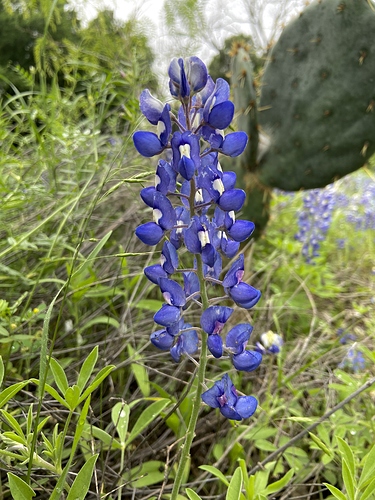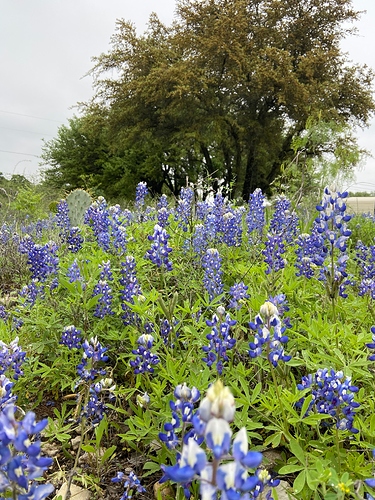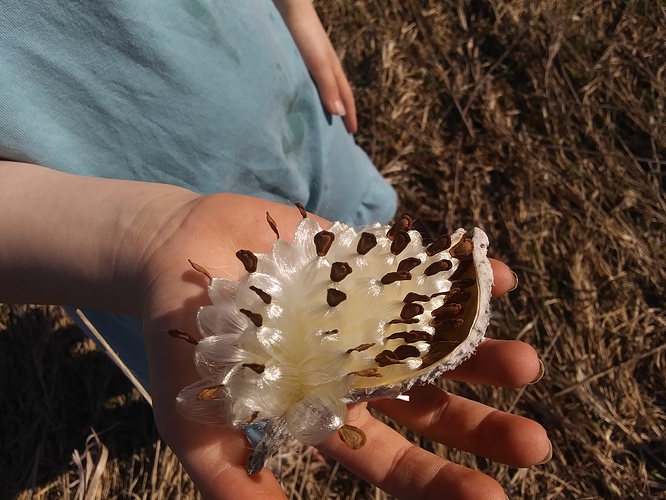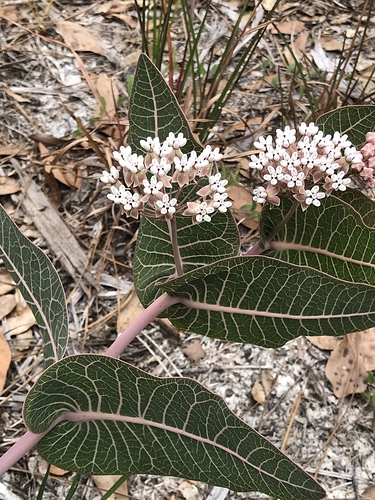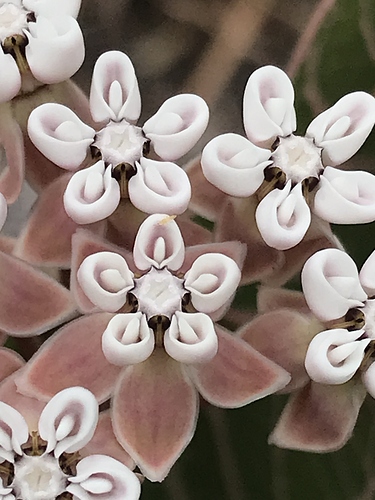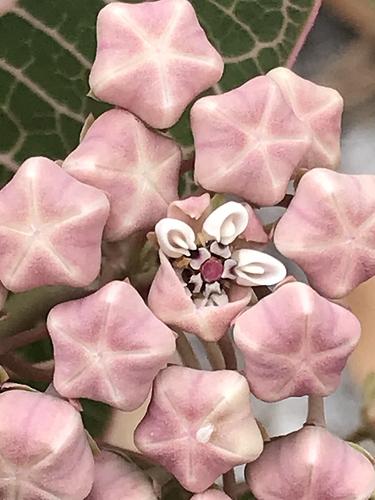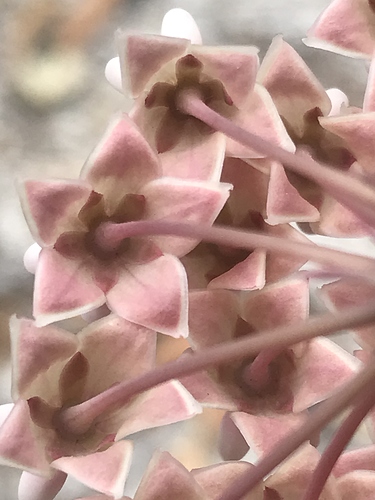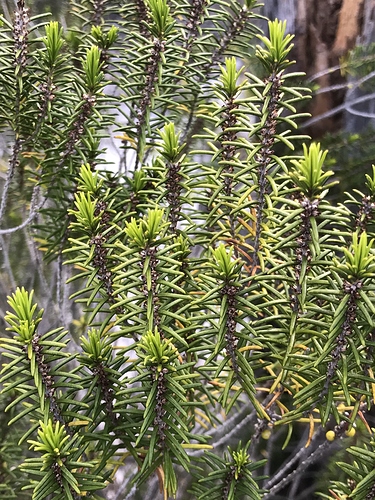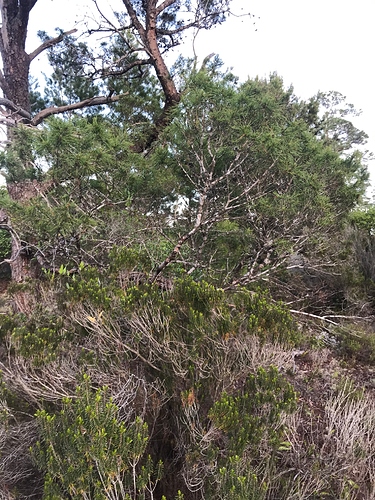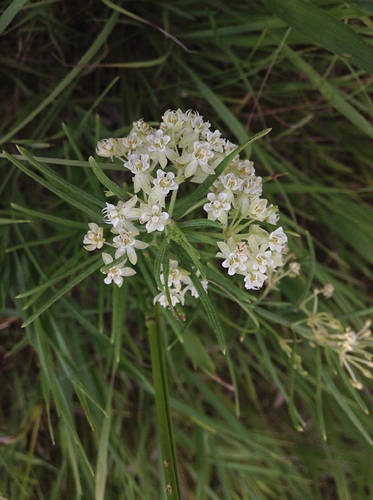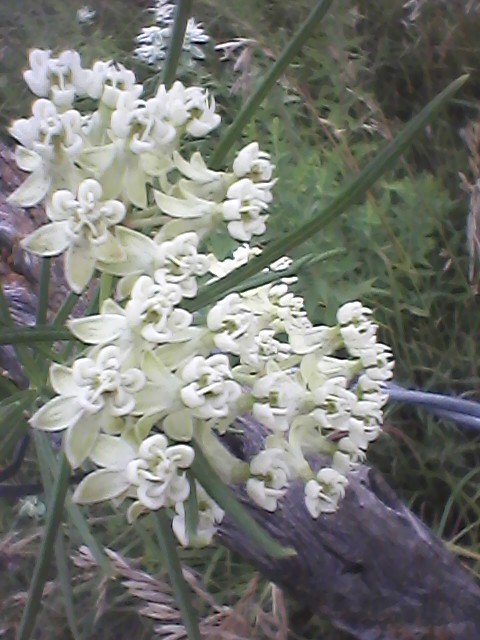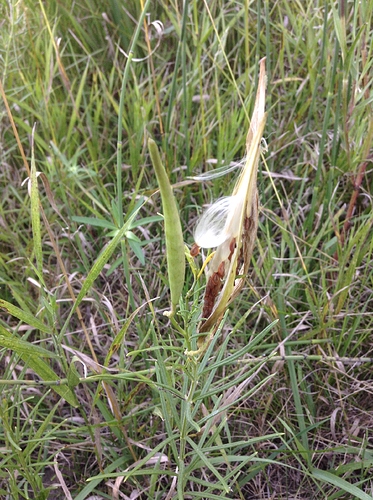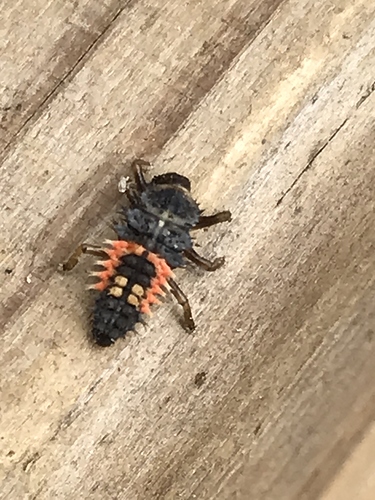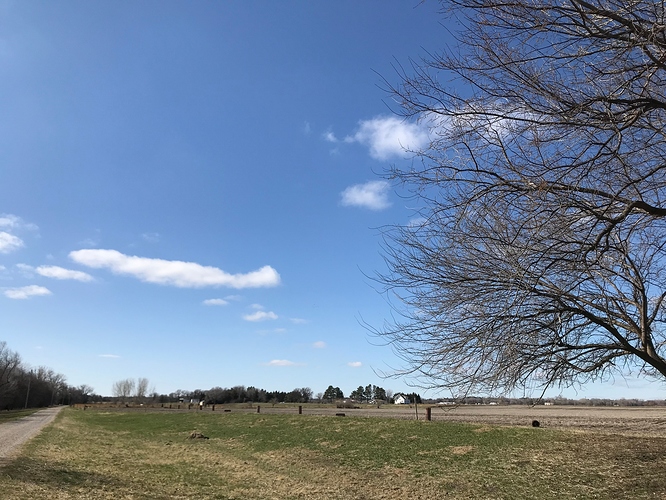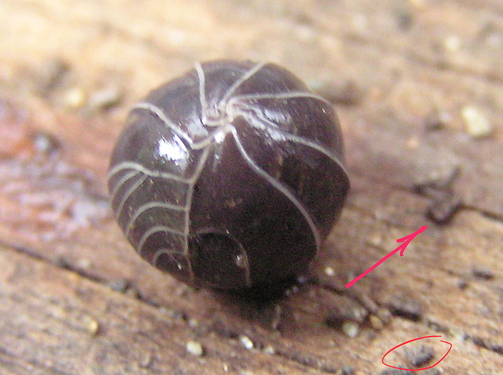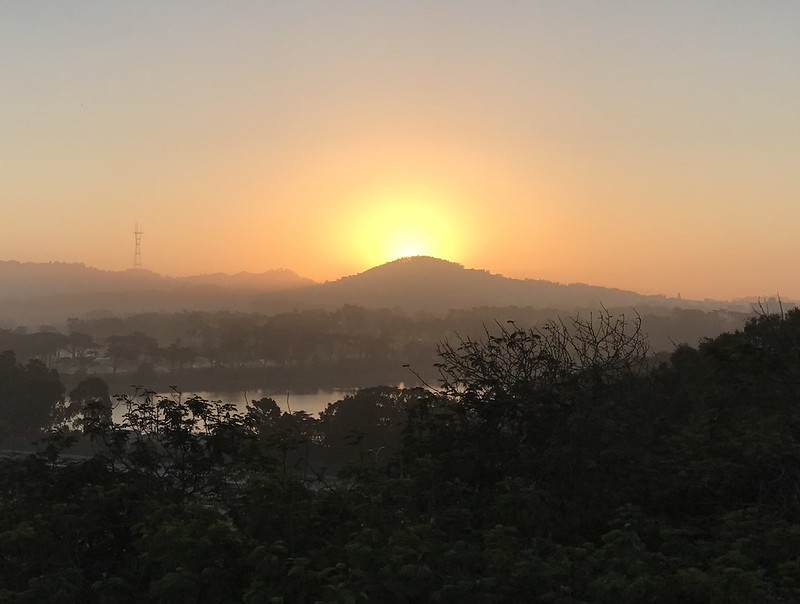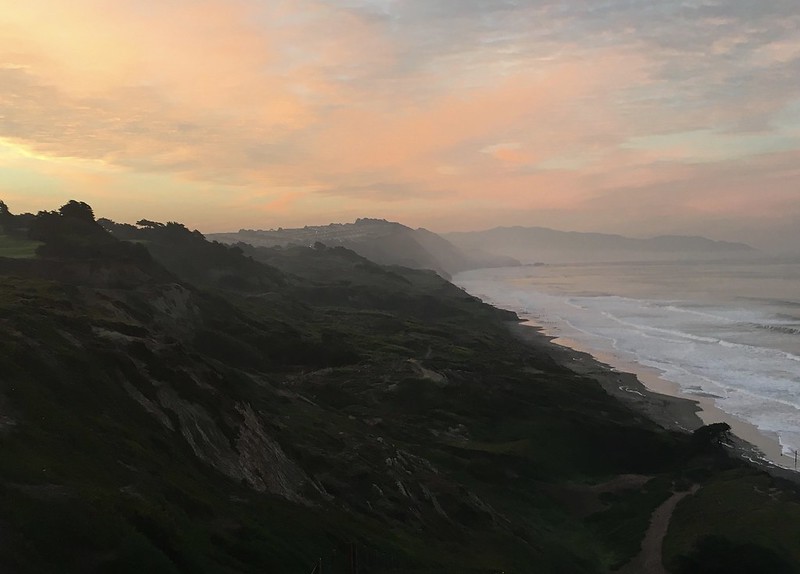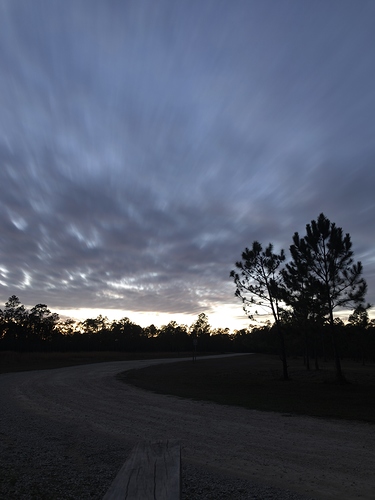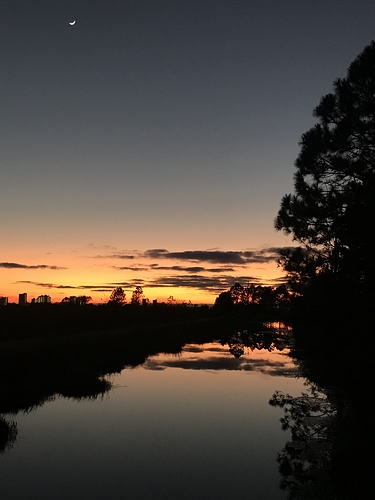Everything’s better with bluebonnets on it!
Here is a plant which has become a weed up and down the coast in California, but a guilty pleasure many of us enjoy seeing anyway. Echium pininana is the species responsible for the extremely tall growth but these may be crossed with the shorter Echium wildpretii as I’ve grown both out here for years along with the deliberate cross known as ‘Mr Happy’. Both echium species hail from the Canary islands. The bright color below is from an ice plant and that above and behind the echiums is a tall growing pelargonium. For reference, the green portion of the fence is 8 feet tall. The echiums are biennial forming a vigorous rosette the first year and then pumping out a giant flower stalk the next … something like a foxglove on steroids.
Here you can see the same pelargonium where it grows on the other side of that fence with the white flowering form of the giant Geranium maderense below. And then from the top of the fence, taken while cutting out the center section of the trellis overhead.
My 6 year old thought the milkweed gossamer was so.pretty that she was going to plant it in my garden yesterday. Oh, and it’s also for the monarch butterflies. Drat those ecology classes!
Milkweed floss is really neat. My favorite milkweed is the Sandhill milkweed. I want to find native pawpaws for local zebra swallowtails and ozark chinquapins. There is one very secret and protected group of ozark chinquapins in my county. Supposedly just 5 trees in my county and those are the only five in the the state and they shove immunity to the chestnut blight. I don’t know where they are. I’ve tried asking and it’s been denied lol. Maybe in a few years I’ll find it. I’ll respect everything though and won’t even collect a seed or fruit from it. It’s just one of the trees I want to see before I die in the wild.
I am sure I shared a milkweed from the past but here is another I took Saturday of the Sandhill milkweed.
![image|375x500]Mine too, now. I wonder if I could make some happy. I’m sure the monarchs would like it just fine. Amazing foliage and flowers.
I have not transplanted any but I’ve planted some seeds from some and they did well. They seem to do best with little attention. They grow in sand so they don’t need constant care. But they grow native here and ive never tried to do any in a garden. Coastal areas change so much. Every 1/2 mile or less you may be traveling a thousands of years worth of land that was slowly exposed. I live about 9 miles north of the coast and though it’s still part of the sand dune region we have very different plants. I do see these growing around here occasionally but they tend to naturally pop up within 1-3 miles on higher elevation sandy areas. Some have deep pink veining and tinted foliage.
One plant I have recently been focusing on is the Sandhill heath or Sandhill rosemary. When I first saw it, before it started to produce flowering buds I thought it was a conifer shrub but it’s actually a angiosperm. The last pic shows one in front of a sand pine and they are really neat. Their pine cones remain on the tree for years and the needles are 1.5-2 inches long. A 1/3 of the length of the short leaf pine which at first threw me off.
We have narrowleaf milkweed, little plants with exquisitely delicate tiny blossoms that are easy to overlook among the grasses.
The pods are slender and small, too:
So this one blew my mind. I could not ID it and asked someone from a group. I never would have guessed this one and despite being a common insect I’ve never seen it at this stage. It’s a baby ladybug of some sort. A ladybug nymph.
looks like you live in a great place for wildlife–with warmth much of the year. Can I guess South Carolina or Georgia? I’ve been getting photos from my sister in North Carolina, and they are about 4 weeks ahead of our Spring. I remember as a teen walking in the woods near Charlotte and seeing a beautiful copperhead–I have never seen a poisonous snake in Michigan (there are only a few Missisauga rattlesnakes, they say). My kids like to chase garter snakes. However, if I went South again, I’d feel like I was back in Africa–shaking out my shoes every morning for scorpions and snakes, and always walking with a flashlight at night. Thanks.
In Niger, most of the land was very dry and scrubby, like Arizona around Phoenix. The rock was reddish brown oceanic basalt, we were told, from underwater volcano eruptions. Despite the dry climate, we had large milkweed with woody stems–sometimes 4-5 inch across, and 20 feet tall. I don’t have a photo on hand, but this is similar to what we saw:

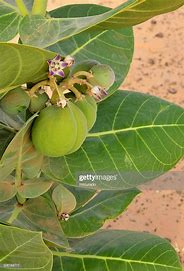
That is one of the good guys. I’ve heard they are even more beneficial at this stage than as adults.
I live in south Alabama for most of the time.
Aka LA. 
(Rolls of snow fence social distancing earlier this week, some lying down on the job. We may have blizzard conditions tomorrow and 3 feet of snow across the lane.)
For some reason (maybe the wood background of your photo) I am reminded of the ubiquitous pill bug and that it suggests something about the Creator’s sense of fun. Aka the common roly poly, woodlouse or armadillid, it rolls up into an amazingly precise spherical shape. When I discovered the little-known fact that it delivers rectangular-ish, even square, excrement, I laughed out loud. (And I’m sure THAT detail was important for its adaptive survival!  ) I still smile or chuckle when I think of it.
) I still smile or chuckle when I think of it.
I never knew there was such a large milkweed but plants are constantly surprising me.
I’m surprised by the range of sizes. Finding the narrowleaf was definitely a surprise – I didn’t know what it was until I figured it out from the latex sap and the similarity of the tiny blossoms to the common milkweed. Of course then I kept an eye on them to watch the pods develop.
How about your favorite time to be out and about in nature? I’m pretty fond of dawn and the fire show it makes in the sky and then watching the light return to what has been in the dark.
Sun rise over Lake Merced and Sutro tower in San Francisco. And then the bluffs over looking Fort Funston beach.
I guess I don’t really have a favorite time. If I do it would be dawn. Early in the morning. I enjoy it because I can go out and locate moths resting on my walls while listening to the songbirds beginning their choir. But my mornings are so busy I don’t really get to enjoy them and so most of my free time to relax and focus on nature is in the evening and at night. I really like full moons screened by thin fast swiftly moving clouds. I enjoy laying on a bench next to a fire and looking up at the stars, thought I don’t know much about cosmetology or identifying constellations. Uploading: 62E67DB0-4D29-4C68-B192-5AB70FD05122.jpeg… Uploading: A16F6705-5029-4A57-BA80-EFA1A857A439.jpeg…
Uploading: 7B99ACFB-FB12-4C20-BF07-060F8F84BD90.jpeg…Maybe it is the scarcity of dawn experiences which keep them fresh and awe inspiring. Most people I know treasure sunsets and they have a similar beauty. All they’re missing is mystique.
Could be. I still feel where I live see way more moths as the sun is coming up and hear way more song birds than when the sun is setting. But I enjoy them all. I will say I enjoy late spring through early fall way more than late fall through early spring. I especially dislike winter.
